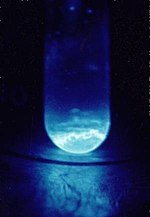Protactinium(V) bromide is an inorganic compound. It is a halide of protactinium, consisting of protactinium and bromine. It is radioactive and has a chemical...
4 KB (409 words) - 20:05, 12 May 2024
Protactinium bromide may refer to: Protactinium(IV) bromide (protactinium tetrabromide), PaBr4 Protactinium(V) bromide (protactinium pentabromide), PaBr5...
511 bytes (51 words) - 23:01, 20 December 2023
alternatively be produced by reacting protactinium pentachloride with hydrogen bromide or thionyl bromide. Protactinium(V) bromide has two similar monoclinic forms:...
50 KB (5,833 words) - 09:01, 25 November 2024
Protactinium(IV) bromide is an inorganic compound. It is an actinide halide, composed of protactinium and bromine. It is radioactive, and has the chemical...
3 KB (347 words) - 13:00, 21 December 2023
alternative reaction is between protactinium pentachloride and hydrogen bromide or thionyl bromide. Protactinium(V) bromide has two similar monoclinic forms...
17 KB (1,760 words) - 22:55, 18 November 2024
bipyramidal, protactinium atoms sharing edges. Protactinium(V) chloride can react with boron tribromide at high temperatures to form protactinium(V) bromide. It...
4 KB (175 words) - 12:41, 5 January 2024
protactinium and iodine, or by reacting protactinium(V) chloride, protactinium(V) bromide or protactinium(V) oxide with silicon tetraiodide. It reacts...
4 KB (308 words) - 12:42, 5 January 2024
Protactinyl nitrate (redirect from Protactinium(V) oxynitrate)
Protactinyl nitrate was first prepared in 1966 by reacting protactinium(V) chloride or protactinium(V) bromide with fuming nitric acid. Lower concentrations of...
3 KB (169 words) - 08:03, 15 November 2024
List of CAS numbers by chemical compound (section V)
glossary of chemical formulae. Contents A B C D E F G H I K L M N O P R S T U V W X Y Z See also External links Chemistry portal "Nitrogen" (PDF). Safety...
139 KB (120 words) - 17:07, 15 July 2024
Protactinium(V) fluoride is a fluoride of protactinium with the chemical formula PaF5. Protactinium(V) fluoride can be obtained by reacting protactinium(V)...
4 KB (377 words) - 20:06, 12 May 2024
Bromine (section Hydrogen bromide)
While it is rather rare in the Earth's crust, the high solubility of the bromide ion (Br−) has caused its accumulation in the oceans. Commercially the element...
67 KB (7,719 words) - 23:39, 21 November 2024
Discovery of nuclear fission (section Protactinium)
found was an isotope of protactinium. This spurred Hahn and Meitner, the discoverers of the most stable isotope of protactinium, to conduct a four-year-long...
99 KB (12,607 words) - 04:05, 20 August 2024
solvents. Protactinium exhibits two valence states; the +5 is stable, and the +4 state easily oxidizes to protactinium(V). Thus tetravalent protactinium in solutions...
123 KB (11,580 words) - 16:09, 20 November 2024
including calcium fluoride, sodium chloride (common table salt), silver bromide and potassium iodide. The group of halogens is the only periodic table...
52 KB (5,499 words) - 17:27, 19 November 2024
List of inorganic compounds (section V)
Iron(II) bromide – FeBr2 Iron(III) bromide – FeBr3 Lead(II) bromide – PbBr2 Lithium bromide – LiBr Magnesium bromide – MgBr2 Mercury(I) bromide – Hg2Br2...
119 KB (8,735 words) - 18:51, 11 November 2024
of dubnium from hydrogen bromide into diisobutyl carbinol (2,6-dimethylheptan-4-ol), a specific extractant for protactinium, with subsequent elutions...
49 KB (9,125 words) - 00:04, 7 November 2024
physicist who was instrumental in the discoveries of nuclear fission and protactinium. Completing her doctoral research in 1905, Meitner became the second...
109 KB (13,284 words) - 17:16, 21 November 2024
lattice De Wolff, P. M.; Belov, N. V.; Bertaut, E. F.; Buerger, M. J.; Donnay, J. D. H.; Fischer, W.; Hahn, Th.; Koptsik, V. A.; MacKay, A. L.; Wondratschek...
49 KB (3,620 words) - 14:56, 4 October 2024
haloalkanes. Examples of Grignard reagents are phenylmagnesium bromide and ethylmagnesium bromide. The Grignard reagents function as a common nucleophile, attacking...
78 KB (8,529 words) - 22:51, 8 November 2024
this behavior is similar to that of neptunium, uranium, thorium and protactinium, but is different from plutonium and curium which show a rapid rise up...
77 KB (9,332 words) - 09:20, 16 November 2024
phase; such +2 state is not observed in many other actinides, including protactinium, uranium, neptunium, plutonium, curium and berkelium. Einsteinium(II)...
67 KB (7,932 words) - 08:59, 25 November 2024
atomic weight of the component halide increases. Neodymium compounds Protactinium compounds Neptunium compounds Kloprogge 2021, pp. 861–862. Seaborg 1968...
13 KB (1,294 words) - 09:38, 19 June 2024
presence of potassium bromide (KBr). These compounds are used in photography to bleach silver images, converting them to silver bromide that can either be...
95 KB (11,386 words) - 07:28, 7 November 2024
downhole metals as corrosive alternative, high-density brines (such as zinc bromide ZnBr 2 solutions) sometimes do; they also require less cleanup and reduce...
93 KB (10,025 words) - 01:18, 22 November 2024
gives the dihydrate RaCl2·2H2O, isomorphous with its barium analog. Radium bromide (RaBr2) is also a colorless, luminous compound. In water, it is more soluble...
78 KB (8,373 words) - 07:31, 11 November 2024
Protactinium(IV) chloride is an inorganic compound. It is an actinide halide, a salt composed of protactinium and chlorine. It is radioactive, and has...
4 KB (357 words) - 19:05, 2 April 2024
analogous to uranocene are known also for other actinides, such as thorium, protactinium, neptunium, plutonium and americium. Molecular orbital theory predicts...
14 KB (1,734 words) - 22:55, 4 November 2024
Uranium (redirect from Uranium(V) iodide)
primarily undergo alpha decay, except for 229U and 231U, which decay to protactinium isotopes via positron emission and electron capture, respectively; the...
110 KB (12,380 words) - 03:12, 26 November 2024
analogous to uranocene are known also for other actinides, such as thorium, protactinium, neptunium, plutonium and americium. Molecular orbital theory predicts...
66 KB (7,821 words) - 09:33, 25 November 2024
Cl− completing the structure. Erbium(III) bromide is a violet solid. It is used, like other metal bromide compounds, in water treatment, chemical analysis...
34 KB (4,174 words) - 09:09, 25 November 2024

















